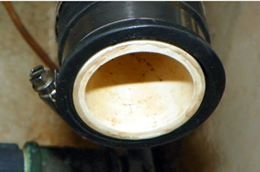Hello all
We have used our boat 600 or so days in the past three years. I rebuilt the Jabsco Quietflush toilets last Fall. They were gross internally. I noticed what I would call a calcification that built up on the lower part of the toilet where water usually sits, even after flushing. I chipped away at it (was disgusting) and cleaning both toilets the best I could. I have heard this happening with seawater flush toilets when seawater and urine interact but ours are fresh water. Any idea what the build up is and if I can prevent it or clean it easily with a chemical or something?
Thanks in advance!
We have used our boat 600 or so days in the past three years. I rebuilt the Jabsco Quietflush toilets last Fall. They were gross internally. I noticed what I would call a calcification that built up on the lower part of the toilet where water usually sits, even after flushing. I chipped away at it (was disgusting) and cleaning both toilets the best I could. I have heard this happening with seawater flush toilets when seawater and urine interact but ours are fresh water. Any idea what the build up is and if I can prevent it or clean it easily with a chemical or something?
Thanks in advance!

